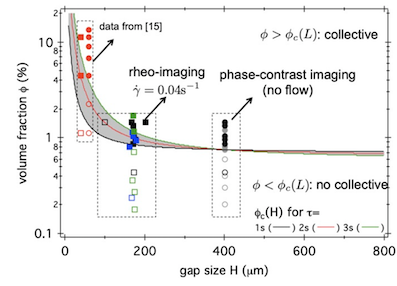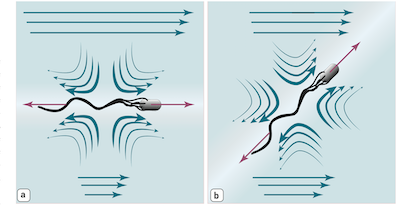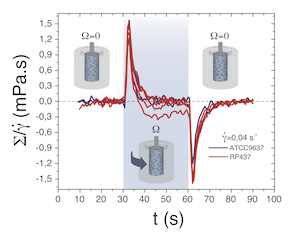Motility of bacteria
Dispersion of motile bacteria in a porous medium

Understanding flow and transport of bacteria in porous media is crucial to technologies such as bioremediation, biomineralization and enhanced oil recovery. While physicochemical bacteria filtration is well documented, recent studies showed that bacterial motility plays a key role in the transport process. Flow and transport experiments performed in microfluidic chips containing randomly placed obstacles confirmed that the distributions of non-motile bacteria stays compact, whereas for the motile strains, the distributions are characterized by both significant retention as well as fast downstream motion. For motile bacteria, the detailed microscopic study of individual bacteria trajectories reveals two salient features: (i) the emergence of an active retention process triggered by motility, (ii) enhancement of dispersion due to the exchange between fast flow channels and low flow regions in the vicinity of the solid grains. We propose a physical model based on a continuous time random walk approach. This approach accounts for bacteria dispersion via variable pore-scale flow velocities through a Markov model for equidistant particle speeds. Motility of bacteria is modelled by a two-rate trapping process that accounts for the motion towards and active trapping at the obstacles. This approach captures the forward tails observed for the distribution of bacteria displacements, and quantifies an enhanced hydrodynamic dispersion effect that originates in the combined effect of pore-scale flow variability and bacterial motility. The model reproduces the experimental observations, and predicts bacteria dispersion and transport at the macroscale. (in coll. with Marco Dentz, Adama Creppy, Éric Clément and Harold Auradou).
Rheology of bacterial superfluids in viscous environments

Viscous environments are ubiquitous in nature and in engineering applications, from mucus in lungs to oil recovery strategies in the earth's subsurface - and in all these environments, bacteria also thrive. The behavior of bacteria in viscous environments has been investigated for a single bacterium, but not for active suspensions. Dense populations of pusher-type bacteria are known to create superfluidic regimes where the effective viscosity of the entire suspension is reduced through collective motion, and the main purpose of this study is to investigate how a viscous environment will affect this behavior. Using a Couette rheometer, we measure shear stress as a function of the applied shear rate to define the effective viscosity of suspensions of Escherichia coli<\i> (E. coli<\i>), while varying both the bacterial density within the suspension and the viscosity of the suspending fluid. We document the remarkable observation that E. coli decreases the effective suspension viscosity to near-zero (superfluidic regime) for all solvent viscosities tested (1-17 mPa s). Specifically, we observe that the bacterial density needed to trigger this superfluidic regime and the maximum shear rate under which this regime can be sustained both decrease with increasing solvent viscosity. We find that the resulting rheograms can be well approximated by the Carreau-Yasuda law. Using this, we propose a constitutive model as a function of the solvent viscosity and the bacterial concentration only. This model captures the onset of the superfluidic regime and offers promising avenues for the modelling of flow of bacterial suspensions in viscous environments. (in coll. with Jane Chui, Harold Auradou and Ruben Juanes).
3D Spatial exploration by E. coli echoes motor temporal variability

Unraveling bacterial strategies for spatial exploration is crucial for understanding the complexity in the organization of life. Bacterial motility determines the spatiotemporal structure of microbial and controls infection spreading and the microbiota organization in guts or in soils. Most theoretical approaches for modeling bacterial transport rely on their run-and-tumble motion. For Escherichia coli, the run-time distribution is reported to follow a Poisson process with a single characteristic time related to the rotational switching of the flagellar motors. However, direct measurements on flagellar motors show heavy-tailed distributions of rotation times stemming from the intrinsic noise in the chemotactic mechanism. Currently, there is no direct experimental evidence that the stochasticity in the chemotactic machinery affects the macroscopic motility of bacteria. In stark contrast with the accepted vision of run and tumble, here we report a large behavioral variability of wild-type E. coli, revealed in their three-dimensional trajectories. At short observation times, a large distribution of run times is measured on a population and attributed to the slow fluctuations of a signaling protein triggering the flagellar motor reversal. Over long times, individual bacteria undergo significant changes in motility. We demonstrate that such a large distribution of run times introduces measurement biases in most practical situations. Our results reconcile the notorious conundrum between run-time observations and motor-switching statistics. We finally propose that statistical modeling of transport properties, currently undertaken in the emerging framework of active matter studies, should be reconsidered under the scope of this large variability of motility features. (in coll. with Nuris Figueroa-Morales, Rodrigo Soto, Gaspard Junot, Thierry Darnige, Vincent A. Martinez, Anke Lindner and Éric Clément).
A combined rheometry and imaging study of viscosity reduction in bacterial suspensions

Suspending self-propelled “pushers” in a liquid lowers its viscos- ity. We study how this phenomenon depends on system size in bacterial suspensions using bulk rheometry and particle-tracking rheoimaging. Above the critical bacterial volume fraction needed to decrease the viscosity to zero, �c ⇡ 0.75%, large-scale collec- tive motion emerges in the quiescent state, and the flow becomes nonlinear. We confirm a theoretical prediction that such instability should be suppressed by confinement. Our results also show that a recent application of active liquid-crystal theory to such systems is untenable. (in coll. with Vincent A.Martinez, Éric Clément, Jochen Arlt, Angela Dawson, Jana Schwarz-Linek, Adama K.Creppy, Viktor Skultéty, Alexander N.Morozov, Harold Auradou and Wilson C. K. Poon).
Rotary motor self-assembly in a drop: putting magnetotactic bacteria to work

From intracellular protein trafficking to large-scale motion of animal groups, the physical concepts driving the self-organization of living systems are still largely unraveled. Self- organization of active entities, leading to novel phases and emergent macroscopic properties, recently shed new light on these complex dynamical processes. Here we show that under the application of a constant magnetic field, motile magnetotactic bacteria confined in water-in- oil droplets self-assemble into a rotary motor exerting a torque on the external oil phase. A collective motion in the form of a large-scale vortex, reversable by inverting the field direction, builds up in the droplet with a vorticity perpendicular to the magnetic field. We study this collective organization at different concentrations, magnetic fields and droplet radii and reveal the formation of two torque-generating areas close to the droplet interface. We characterize quantitatively the mechanical energy extractable from this new biological and self-assembled motor. (in coll. with Benoit Vincenti, Gabriel Ramos, Maria Luisa Cordero, Carine Douarche, Rodrigo Soto and Éric Clément).
Effect of motility on the transport of bacteria populations through a porous medium

The role of activity on the hydrodynamic dispersion of bacteria in a model porous medium is studied by tracking thousands of bacteria in a microfluidic chip containing randomly placed pillars. We first evaluate the spreading dynamics of two populations of motile and nonmotile bacteria injected at different flow rates. In both cases, we observe that the mean and the variance of the distances covered by the bacteria vary linearly with time and flow velocity, a result qualitatively consistent with the standard geometric dispersion picture. However, quantitatively, the motile bacteria display a systematic retardation effect when compared to the nonmotile ones. Furthermore, the shape of the traveled distance distribution in the flow direction differs significantly for both the motile and the nonmotile strains, hence probing a markedly different exploration process. For the nonmotile bacteria, the distribution is Gaussian, whereas for the motile ones, the distribution displays a positive skewness and spreads exponentially downstream akin to a Gamma distribution. The detailed microscopic study of the trajectories reveals two salient effects characterizing the exploration process of motile bacteria: (1) the emergence of an “active” retention effect due to an extended exploration of the pore surfaces and (2) an enhanced spreading at the forefront due to the transport of bacteria along “fast tracks” where they acquire a velocity larger than the local flow velocity. We finally discuss the practical applications of these effects on the large-scale macroscopic transfer and contamination processes caused by microbes in natural environments. (in coll. with Adama Creppy, Éric Clément, Maria Veronica D’Angelo and Harold Auradou).
Actuated rheology of active magnetic suspensions: Emergence of motor and brake states

We study the effect of magnetic field on the rheology of magnetic micro-swimmers suspensions. We use a model of a dilute suspension under simple shear and subjected to a constant magnetic field. Particle shear stress is obtained for both pusher and puller types of micro-swimmers. In the limit of low shear rate, the rheology exhibits a constant shear stress, called actuated stress, which only depends on the swimming activity of the particles. This stress is induced by the magnetic field and can be positive (brake state) or negative (motor state). In the limit of low magnetic fields, a scaling relation of the motor-brake effect is derived as a function of the dimensionless parameters of the model. In this case, the shear stress is an affine function of the shear rate. The possibilities offered by such an active system to control the rheological response of a fluid are finally discussed. (in coll. with Benoît Vincenti and Éric Clément).
Bacterial suspensions under flow

Fluids laden with motile bacteria enter in the category of active matter, a new field currently developing at the convergence of biology, hydrodynamics and statistical physics. Such suspensions were shown recently to exhibit singular macroscopic transport properties. In this paper we review some recent results, either theoretical or experi- mental, on the active fluid rheology. We focus principally on bacteria suspensions and the objective is to provide the basis for understanding the emergence of the singular constitutive relations characterizing the macroscopic transport properties of such an active fluid under flow. (in coll. with Éric Clément, Anke Lindner and Harold Auradou).
Viscosité d’une suspension de bactéries: des efforts individuels aux efforts collectifs

En 1906, Albert Einstein a montré que l’ajout de particules sphériques solides dans un fluide augmente sa viscosité. En est-il encore ainsi quand les particules sont « actives » (c’est-à-dire motiles) ? Des expériences récentes avec des suspensions de bactéries Escherichia coli, qui sont de type « pousseur », démontrent un effet opposé : aux faibles taux de cisaillement, la viscosité macroscopique du liquide chute jusqu’à devenir nulle. Ce phénomène vient essentiellement du fait que la puissance motrice des bactéries contribue à la puissance mécanique fournie au fluide pour assurer son écoulement, cette contribution ayant une valeur nette non nulle en raison de l’organisation de la nage des bactéries soit individuellement, soit collectivement. (in coll. with Harold Auradou, Adama Creppy, Hector Matias Lopez et Éric Clément).
Turning Bacteria Suspensions into Superfluids

The rheological response under simple shear of an active suspension of Escherichia coli is determined in a large range of shear rates and concentrations. The effective viscosity and the time scales characterizing the bacterial organization under shear are obtained. In the dilute regime, we bring evidence for a low-shear Newtonian plateau characterized by a shear viscosity decreasing with concentration. In the semidilute regime, for particularly active bacteria, the suspension displays a “superfluidlike” transition where the viscous resistance to shear vanishes, thus showing that, macroscopically, the activity of pusher swimmers organized by shear is able to fully overcome the dissipative effects due to viscous loss. (in coll. with Matías López, Jérémy Gachelin, Harold Auradou and Éric Clément)
Effects of population density and chemical environment on the behavior of Escherichia coli in shallow temperature gradients

In shallow temperature gradients, changes in temperature that bacteria experience occur over long time scales. Therefore, slow processes such as adaptation, metabolism, chemical secretion and even gene expression become important. Since these are cellular processes, the cell density is an important parameter that affects the bacteria's response. We find that there are four density regimes with distinct behaviors. At low cell density, bacteria do not cause changes in their chemical environment; however, their response to the temperature gradient is strongly influenced by it. In the intermediate cell-density regime, the consumption of nutrients becomes significant and induces a gradient of nutrients opposing the temperature gradient due to higher consumption rate at the high temperature. This causes the bacteria to drift toward low temperature. In the high cell-density regime, interactions among bacteria due to secretion of an attractant lead to a strong local accumulation of bacteria. This together with the gradient of nutrients, resulted from the differential consumption rate, creates a fast propagating pulse of bacterial density. These observations are a result of classical nonlinear population dynamics. At extremely high cell density, a change in the physiological state of the bacteria is observed. The bacteria, at the individual level, become cold seeking. This appears initially as a result of a change in the methylation level of the two most abundant sensing receptors, Tsr and Tar. It is further enforced at an even higher cell density by a change in the expression level of these receptors. (in coll. with Mahmut Demir, Anna Yoney, Albert Libchaber and Hanna Salman).
E. coli and Oxygen: A Motility Transition

The motility of Escherichia coli is correlated with oxygen concentration. We show that oxygen penetrating into an anaerobic sample induces the coexistence of two domains of motile and nonmotile bacteria. This coexistence generates a bacterial accumulation at the border that propagates slowly with a constant velocity. To show that this front propagation follows general scaling arguments, we characterize the sharp and fast motile to nonmotile transition occurring when bacteria exhaust oxygen. Additionally, we develop a novel technique to quantify oxygen in situ without affecting bacteria. (in coll. with Hanna Salman, Axel Buguin and Albert Libchaber)